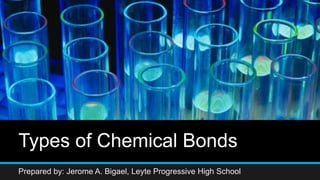
Types of Chemical Bonds
- 1. Types of Chemical Bonds Prepared by: Jerome A. Bigael, Leyte Progressive High School
- 2. What is Chemical Bonds? •A chemical bond is a lasting attraction between atoms that enables the formation of chemical compounds.
- 3. Types of Bonds • Covalent bond (share electrons) bonds that involve the sharing of a pair of valence electrons by two atoms. • Ionic Bond (transfer electrons) bond in which one or more electrons from one atom are removed and attached to another atom, resulting in positive and negative ions which attract each other.
- 4. Other types of Bonds • Metallic bonds is the force of attraction between valence electrons and the metal atoms. • Hydrogen bonding it is a force of attraction between a hydrogen atom in one molecule and a small atom of high electronegativity in another molecule.
- 5. Covalent Bonds •Covalent bonding can be visualized with the aid of Lewis diagrams.
- 7. •How does this sharing of electrons affect the structure and the properties of substance?
- 8. Electronegativity •The extent of sharing of electrons between atoms in a molecule is dependent on the electronegativity. •Electronegativity is the ability of each atom in a chemical bond to attract electrons toward it.
- 9. •This affects a substance’s polarity and interaction with other substances. •Recall that each atom has its own electronegativity value (eV).
- 10. • The Higher the electronegativity value, the higher the tendency of the atom to attract electrons toward it. • In the case of H2, O2, and N2, there is equal sharing of electrons in the covalent bond of each molecule because the bonded atoms are of the same kind.
- 11. •Thus, they have the same electronegativity value. •The Bond that exist between these kind of atom is called nonpolar covalent bond. •These kind of bond forms non-polar molecules.
- 12. •On the other hand, Let us look at hydrogen Chloride (HCl), which has different atoms involved in the covalent bond. •Hydrogen has an electronegativity of 2.1 while chlorine has an electronegativity of 3.0.
- 13. • Because chlorine has a higher electronegativity value, electrons tend to lean toward chlorine; thus, electrons in two different atoms involved in the bond are unequally shared and a polar covalent bond is formed. • This kind of bond forms a polar molecule.
- 14. •Due to unequal sharing of electrons, the electron cloud leans toward the more electronegative element. •This forms partial positive and partial negative charges.
- 15. • Because the electrons are residing more on the chlorine atom, the electron cloud of chlorine is larger than that of hydrogen.
- 16. • In this case, the hydrogen atom has lower electronegativity value; thus, it acquires the partial positive charge, and the shared electrons are pulled away from it. • On the other hand, the chlorine atom, which has a higher electronegativity value, acquires the partial negative charge; the electrons are residing more on its side.
- 17. •Therefore, the dipole moment (symbolized by a crossed arrow) is directed toward the chlorine atom.
- 18. Dipole moment •Dipole moments occur when there is a separation of charge. •The dipole moment is a measure of the polarity of the molecule.
- 19. Electronegativity Difference What is Electronegativity? •It is the ability of an atom in a chemical bond to attract electrons toward it. Electronegativity values are found in your periodic table.
- 20. •Based on Linus Pauling’s scale, fluorine is the most electronegative element, while francium is the least electronegative.
- 22. •The difference in the electronegativity values of the atoms in a molecule or a compound determines the type and polarity of bond that is formed.
- 23. •An ionic bond is formed when the difference in electronegativity values (∆EN) of the element is greater than or equal to 2.0 eV. Electronegativity difference Type of Bond ∆EN≥2.0 Ionic 0.5<∆EN<2.0 Polar Covalent 0<∆EN≤0.5 Non polar Covalent
- 24. • A nonpolar covalent bond is formed when the difference in electronegativity value is equal to or less than 0.5 eV. Electronegativity difference Type of Bond ∆EN≥2.0 Ionic 0.5<∆EN<2.0 Polar Covalent 0<∆EN≤0.5 Non polar Covalent
- 25. • On the other hand, a polar bond is formed when the difference in electronegativity values is greater than 0.5 eV but is less than 2.0 eV. Electronegativity difference Type of Bond ∆EN≥2.0 Ionic 0.5<∆EN<2.0 Polar Covalent 0<∆EN≤0.5 Non polar Covalent
- 27. Classify each molecule as having a polar or a nonpolar covalent bond. Then draw the dipole moment for each molecule. Indicate the partial positive side a d the partial negative side. 1. CO2 2. H2O 3. CH4 4. HBr 5. NH3
- 28. Electronegativity Difference and Type of Bond Electronegativity difference Type of Bond ∆EN≥2.0 Ionic 0.5<∆EN<2.0 Polar Covalent 0<∆EN≤0.5 Non polar Covalent